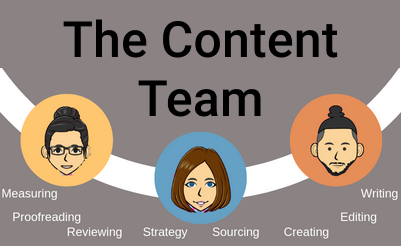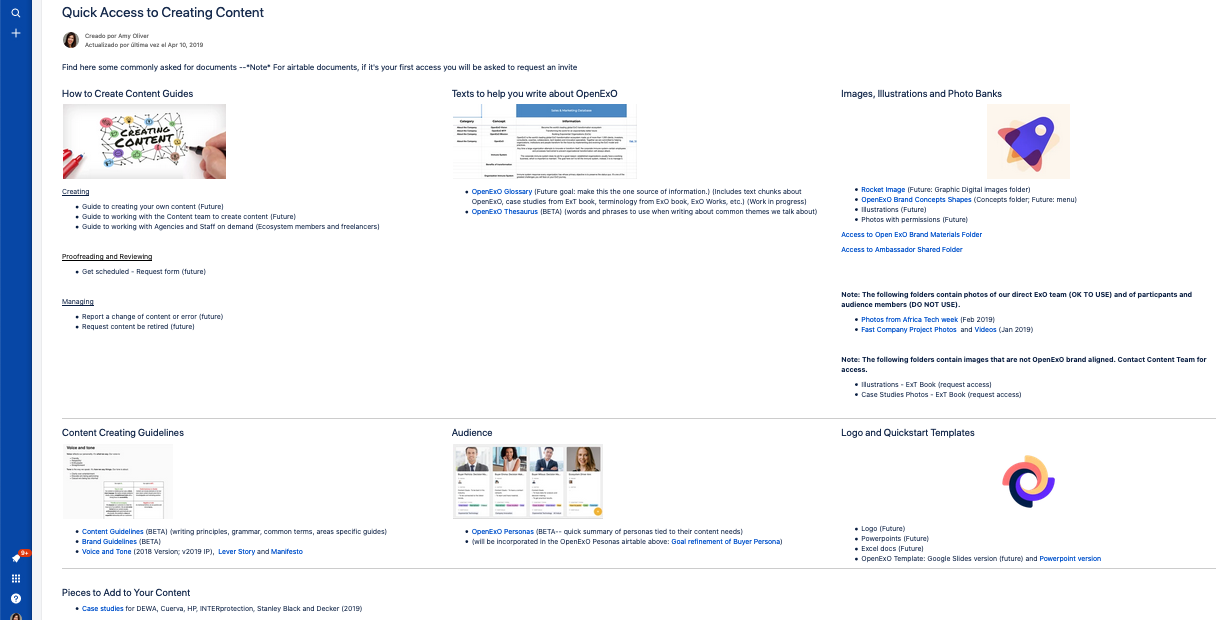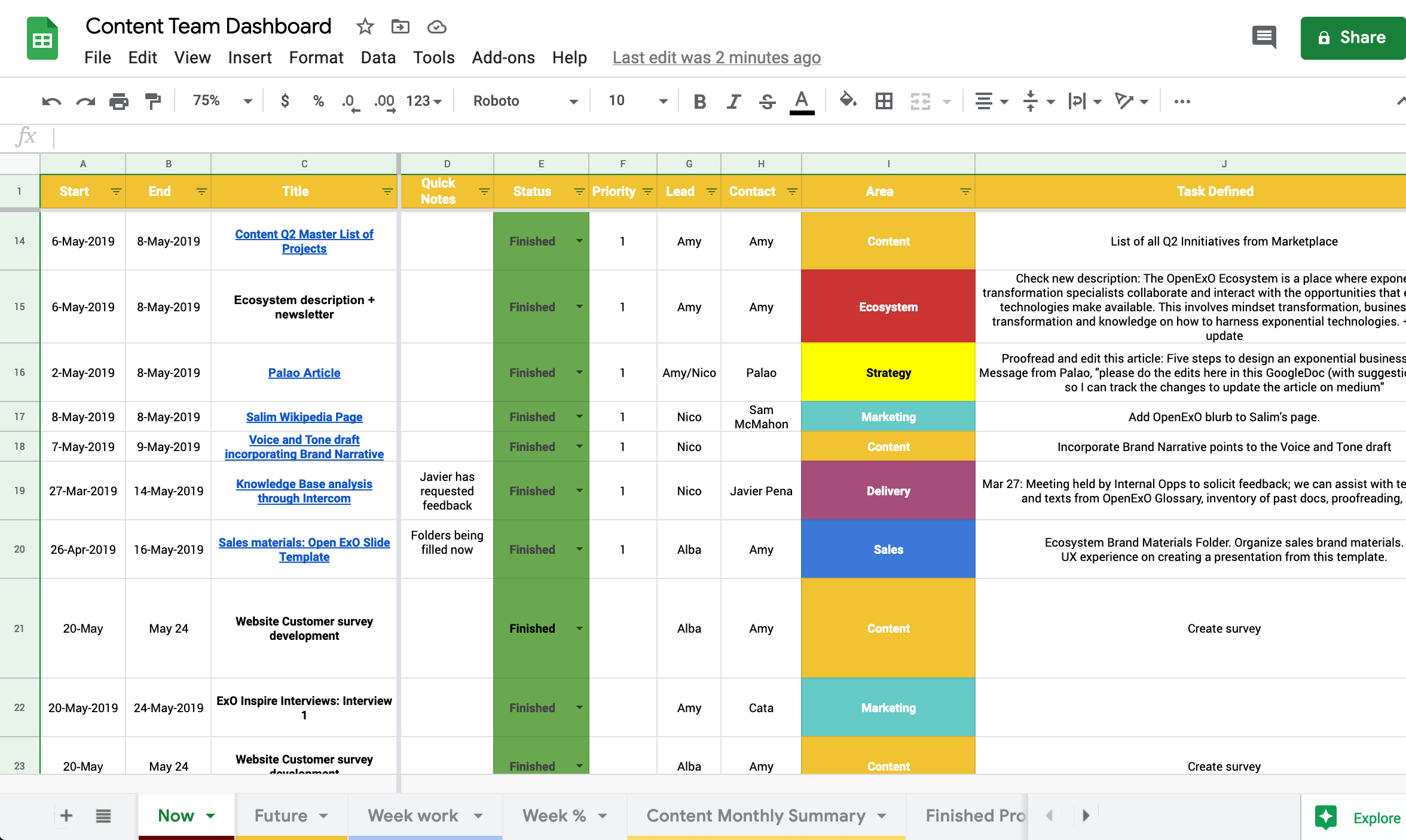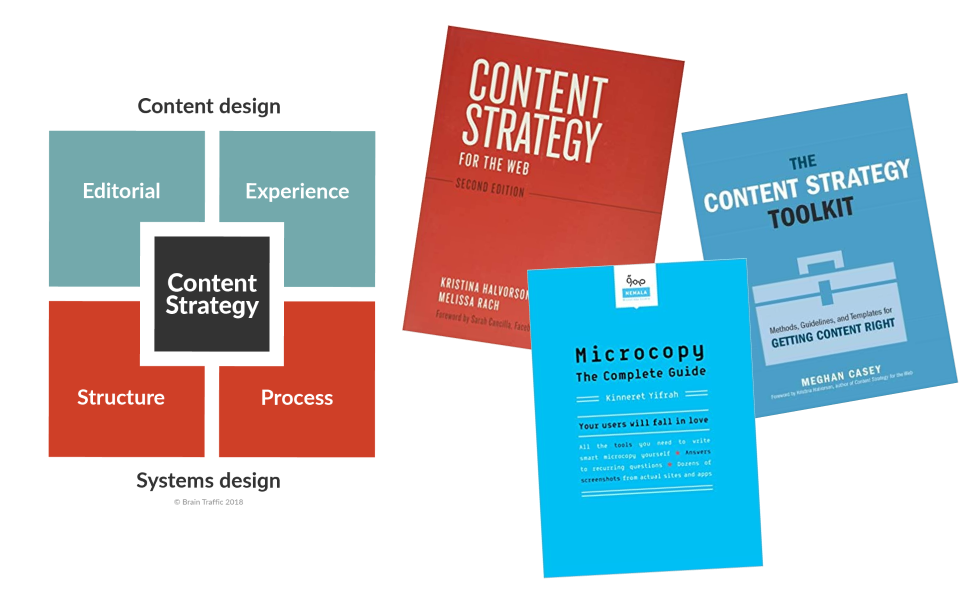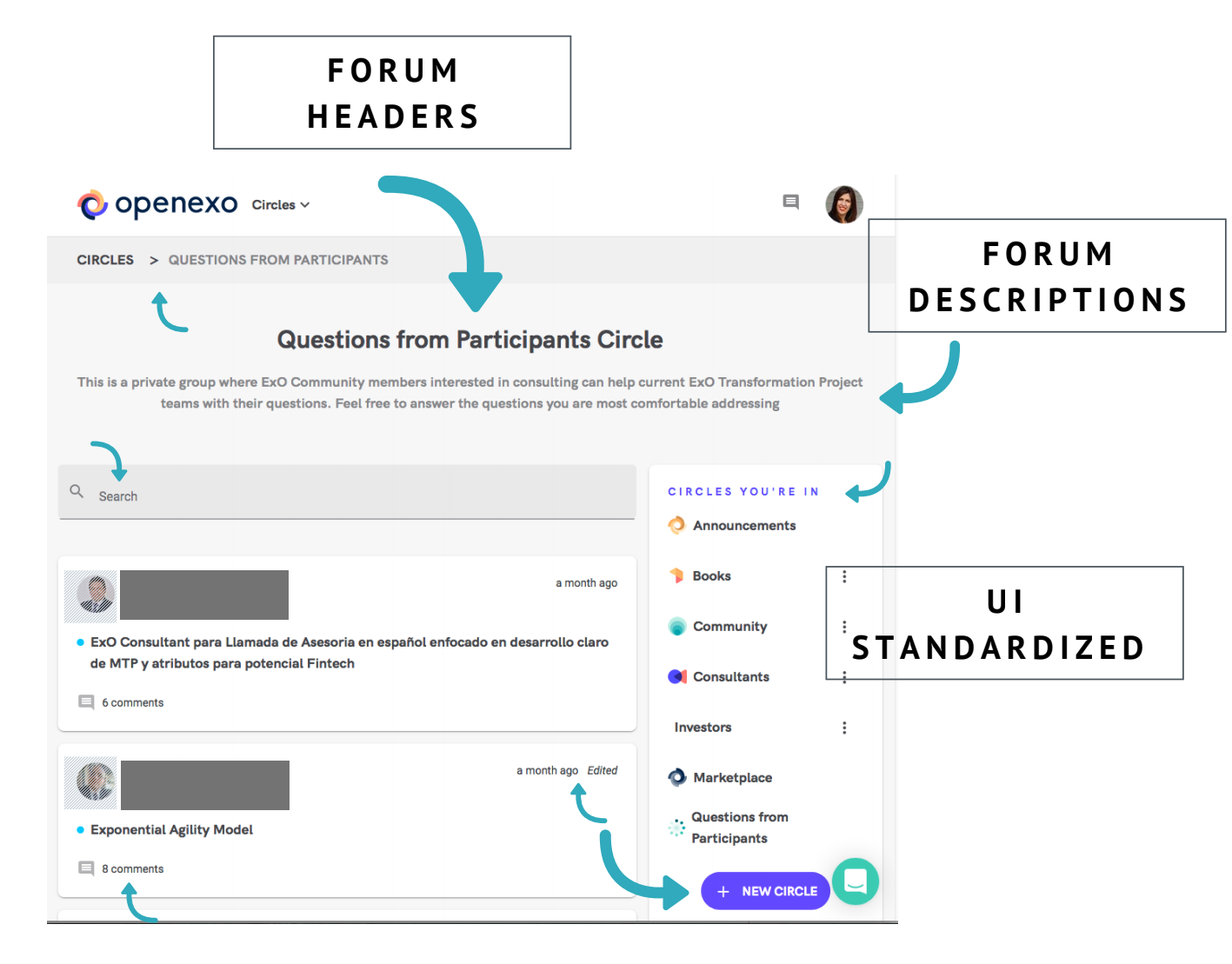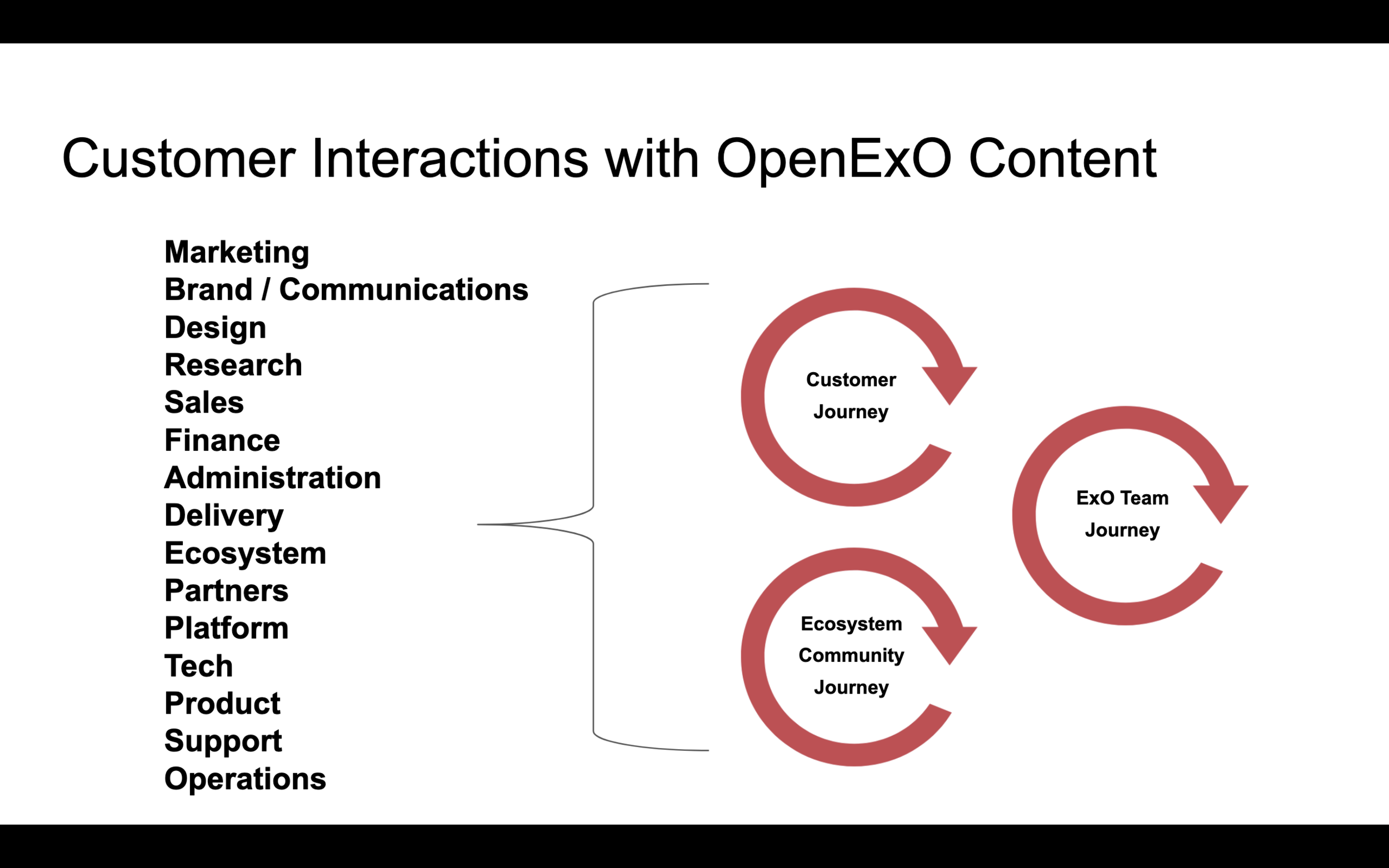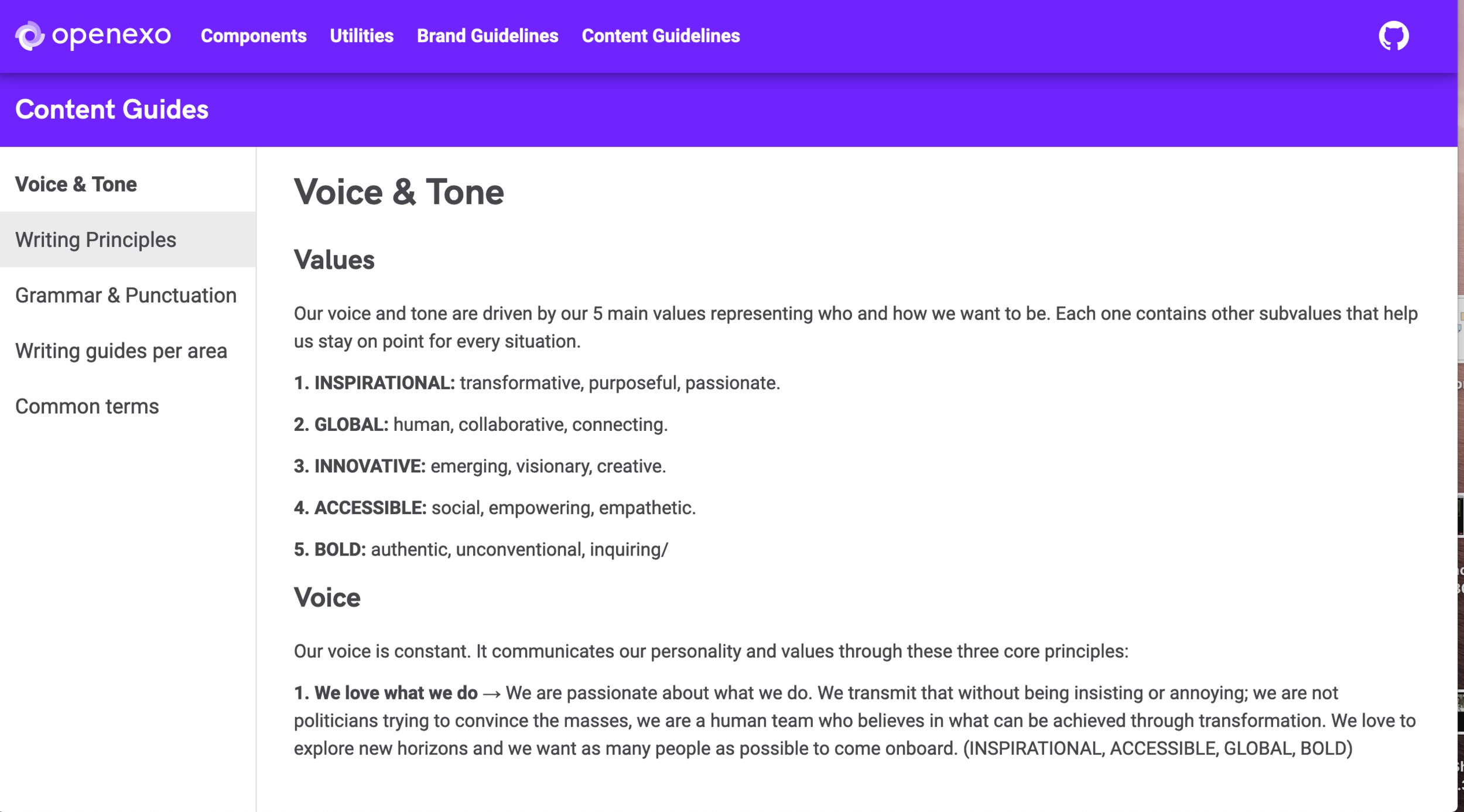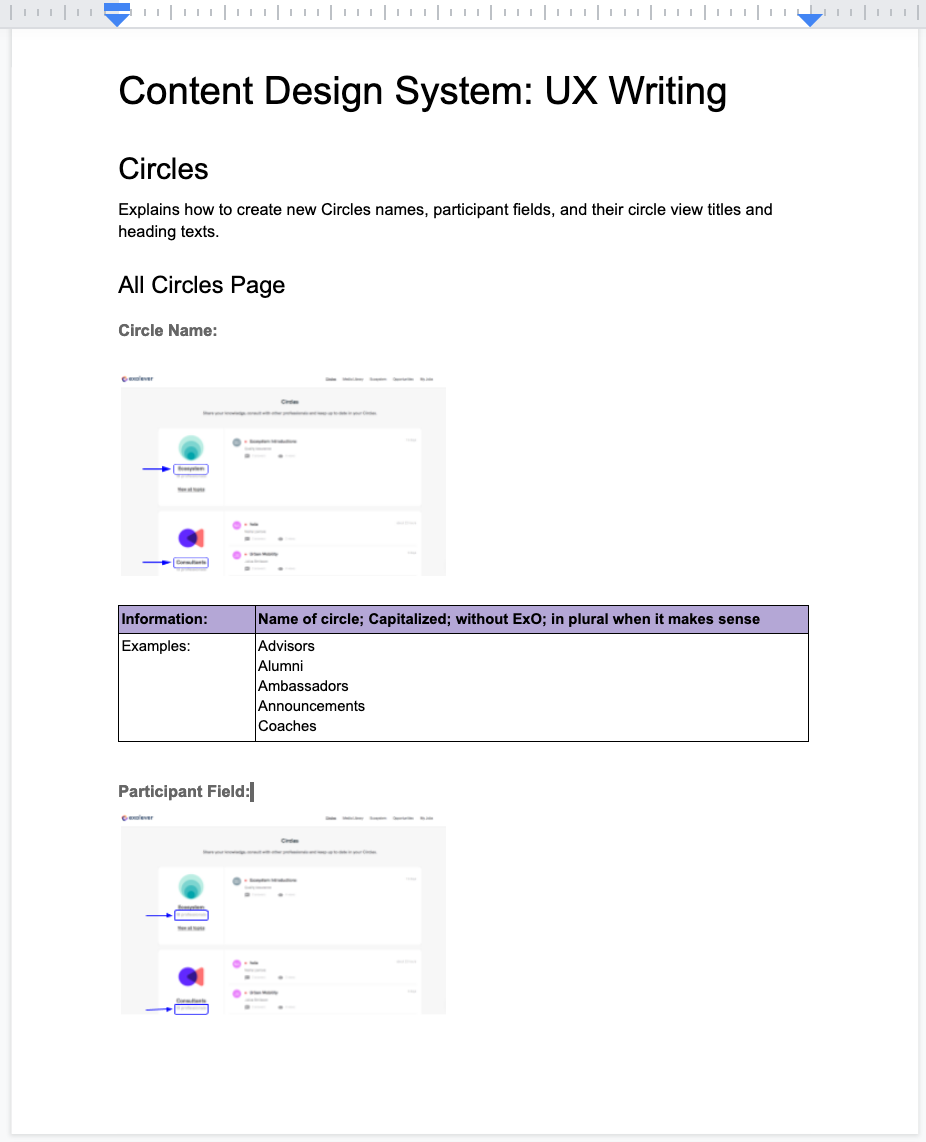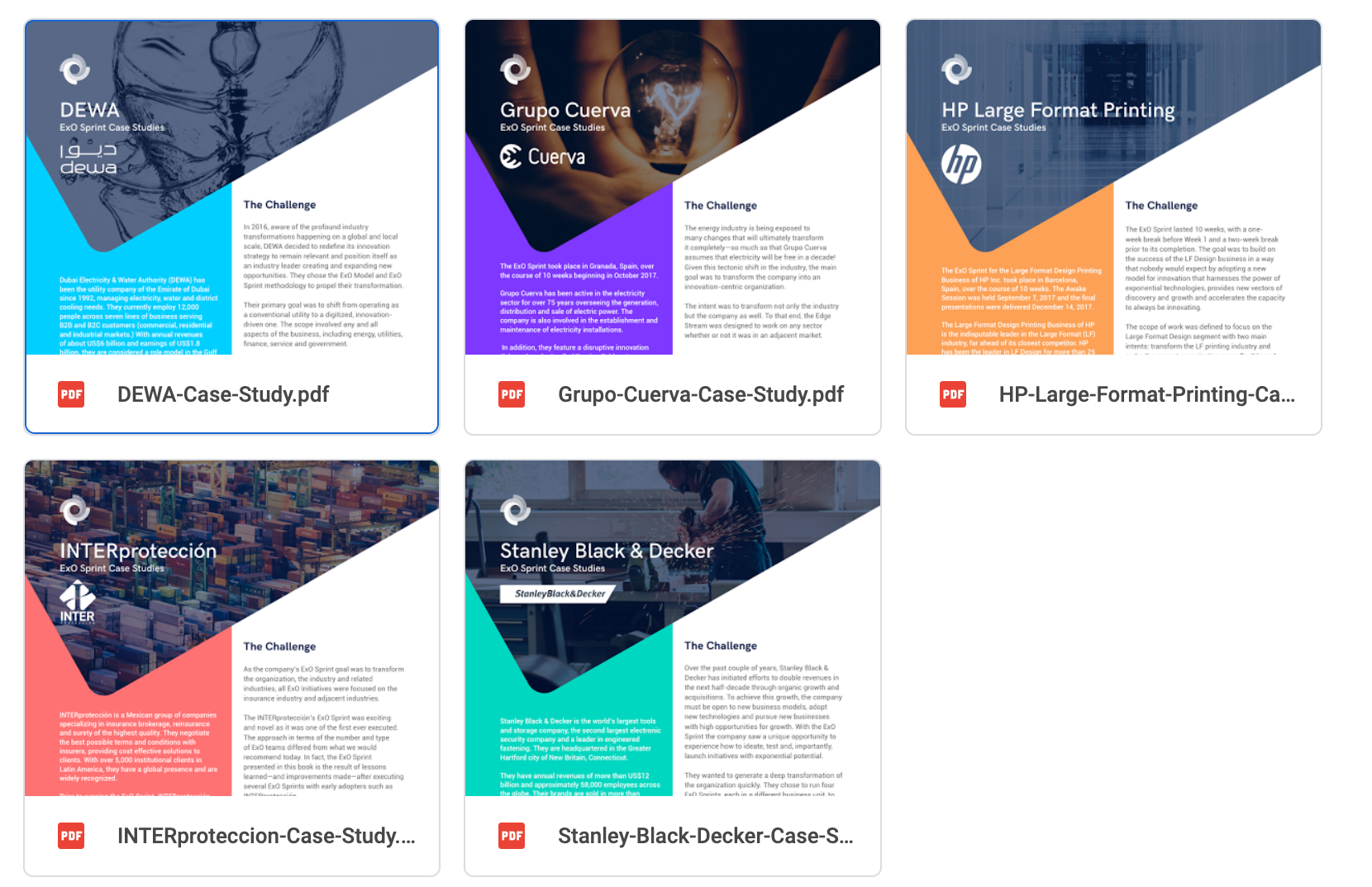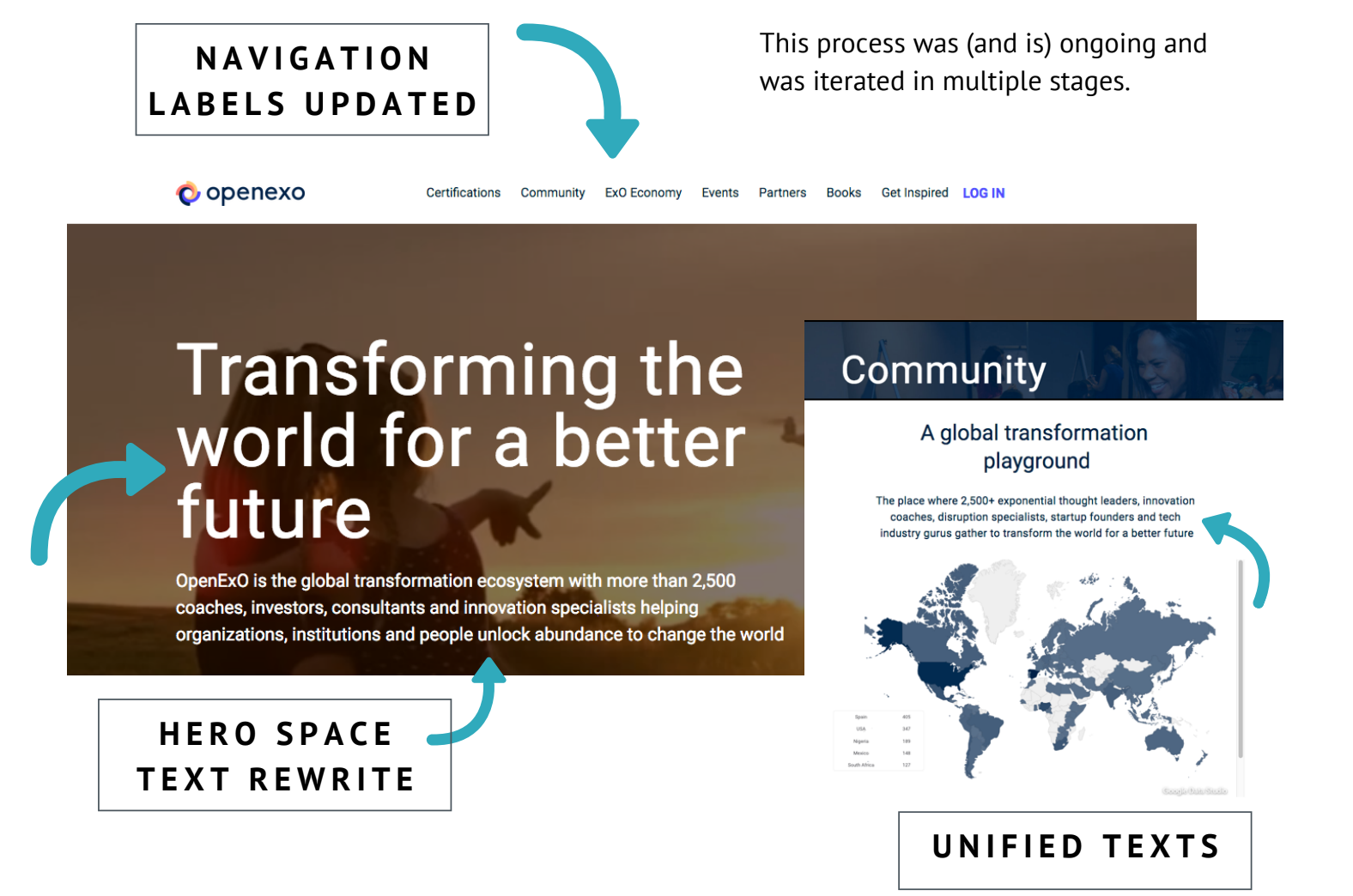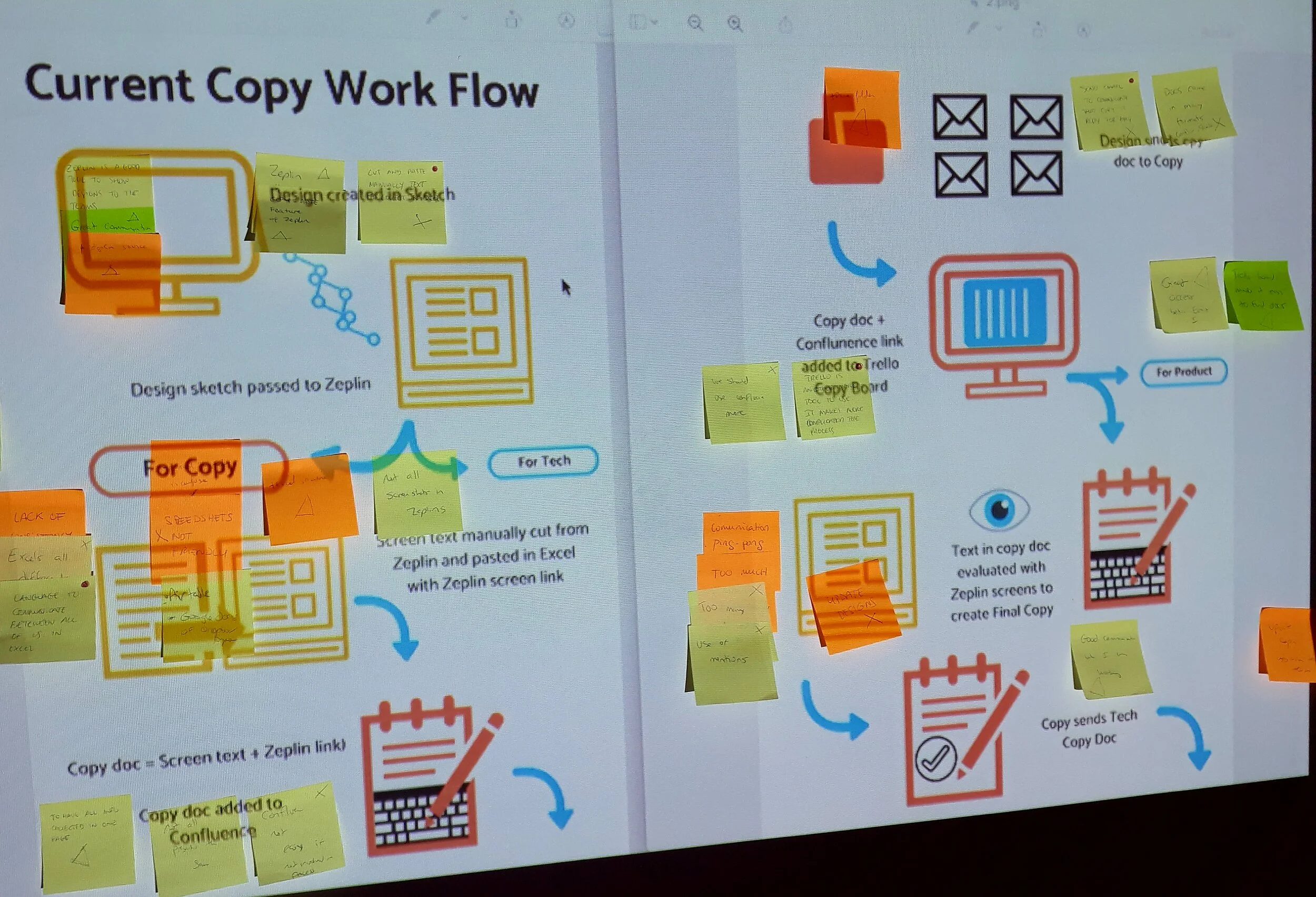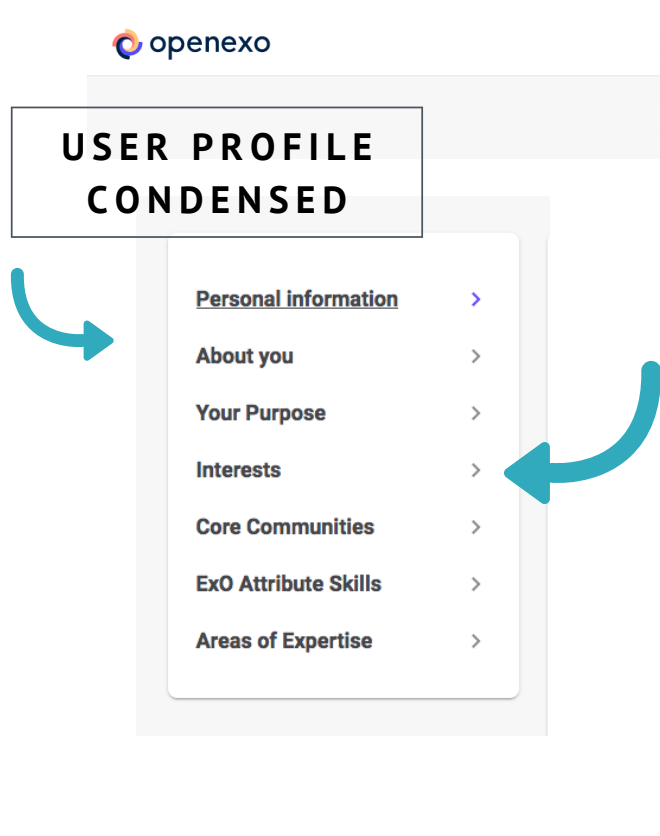
OpenExO Content Operations
A Case Study
Project Management
The Team
I joined OpenExO when it was a tight-knit startup called ExO Lever. I worked with innovation and technology community members and internally on cross-disciplinary teams made up of C-suite stakeholders, product managers, developers, designers, researchers, and the operations, delivery, marketing, sales, legal and accounting areas.
As the company and content needs grew, I hired and mentored a content designer and a content intern.
Communications
Company
Team members were located around the world with the developer and design base located in Granada, Spain. We worked in different time zones, speaking in English and Spanish. The organizational structure was flat and made of cross-disciplinary teams with a focus on transparency and shared access to information. Teamwide communications were coordinated through Confluence, Jira, Slack, email, Zoom, Trello, Google Drive. We used proprietary company methodology as well as Lean Startup, Design Thinking, Agile-Kanban-Scrum practices.
Content Team
To facilitate communication and transparency, I created real-time dashboards located in a content hub in Confluence.
The Content Hub
Content Team Project Dashboard
The Work
Phase I: Product Platform
My first project was to untangle years of copy debt in the digital platform. The platform had multiple portals and permissions for different users and offered forums, innovation team workspaces, a multimedia library and eventually public profiles, certification badges and a marketplace.
I ran a Voice and Tone development workshop with the stakeholders and created the first writing guides. I crafted product texts, updated navigation labels, wrote email notifications, standardized repeating messages (success/error notifications, buttons, empty states) and created copy design systems.
Phase II: Enterprise Content Design
With the platform language stable, I next turned to establishing an enterprise content strategy. Together with design, research and new content team members, we worked like an internal agency serving the company’s content needs as well as the community of innovation consultants.
During this time we launched a new cryptocurrency, published a book on innovation sprint methodology, rebranded to become OpenExO, offered a new online 10-week sprint, grew the community of disruptive innovation specialists and developed a certification program.
My go-to resources
A few examples of copy I wrote for the platform
Enterprise Content Strategy and Design
Understanding Clients the Business and the Product
I conducted interviews with internal stakeholders and sat in on client research interviews as often as possible to better understand the needs of:
internal teams creating content
innovation consultants
business clients seeking transformation
Innovation consultants and clients come from a non-homogeneous community of emerging technology specialists, transformation coaches, consultants, business investors, fortune 100 businesses, government departments and small family run businesses seeking transformation.
Content Strategy
The challenge was to solve for different client segment pain points while working towards product market fit. Internal stakeholders lost a lot of time tracking down the most up-to-date information and external clients suffered from the fragmented use of different names for the same products and overly complex language.
My goal was to create a hybrid content creation model where some teams relied on content team writers while others created and published their own content autonomously or through external writers.
After researching the content landscape, I created a first-version content strategy and initial workflow processes.
To address these problems, the content team got together with marketing and design to create branding materials and amass brand aligned image and video banks with photo release forms. Together with operations we organized a content hub with fast access to content creating documents and information.
In my days as the lone-writer I had started a source-of-truth terminology glossary and platform copy design docs with screen flows sourced through a developer-side sandbox. We grew these to guide and support use of consistent brand voice and terminology.
In follow up interviews, many teams reported that the content hub and source-of-truth terminology document increased their efficiency, shaving off hours of work. Developers were delighted with the platform copy design docs as they could insert preapproved copy without needing to talk to anyone.
Content Design
Just a few of the MANY projects we collaborated on include defining the brand, swapping out the old name everywhere, UX writing for the platform marketplace, creating sales decks, creating templates for the innovation community, editing Medium articles, running core model website workshops, editing legal forms, copywriting for summits and workshops...
Measurement & Testing
We were a very productive team, however one area I would like to have done better at was setting real and meaningful analytic based metrics at the start of content projects. While I did consult platform metrics from Hotjar and Google analytics, I tended to rely heavily on qualitative measurements, such as testing navigation language during user interviews or through feedback sessions with internal teams.
Solving Roadblocks
Managing Overdemand for Content Services
A problem every writing team faces is what to do when you become too popular. This was true when I was the lone writer on the team and increased as the content team grew.
Many times different areas would approach us with projects, not aware of our backlog. As business priorities shifted from week to week, we couldn’t use a first-come-first-served formula to attend everyone.
I depended on business strategy and operations to coordinate with the entire team the TOP priorities and then made decisions on quality and scope from there. I created transparent practices so that anyone on the team could easily find out what we were working on during any given week and what percentage of our work was dedicated to the different projects. I didn’t always make everyone happy, but as a team we did a great job of producing a lot of useful copy and content focused on business and client needs.
“Project time logs help you understand how long tasks take for future estimates.”
Improving Workflows
One pain point suffered by the developers, UX/UI designers and content designers was how to effectively and efficiently pass changes to one another.
I had a rough start my first week of work when I was given an alphabetical list of ALL the platform copy, 1000+ lines in a .csv file. It was this mashup of techno robot (“error, error”), Valley girl (“awesome! hit that button”), poor translations (“Manage all your jobs are doing”) and a mix of British and American English written my multiple past writers. I needed to see the screens, to know what came before, what came after.
We initially used a combination of Sketch, Zeplin and Google Sheets copy docs to communicate copy. The developers and the design team wanted a workflow that would allow copy to be directly entered into the platform without passing through the developers, however due to technical debt and two combined platforms, there was never enough time to develop a string system. Developers admitted that the current experience was a bit clunky but the quality of the information received made up for it.
I ran a retrospective with the developer team to discuss ways to improve the workflows using a swarm session tool that was one of our products. This highlighted the copy bugs and technical bugs as well as created more team union as we “ate our own dog food” together.
I successfully advocated for a writer to be included at the earliest design stages for all new platform projects to save time and money.
It took a few rounds to get to know what would work best for each of the teams but we got there.
“People over processes.”
Successes
We achieved user growth of 600% in one year.
We created value for the innovation and transformation community through events, summits, webinars, books, certification opportunities, public profiles and job opportunities with clients.
Each of these were supported with content infrastructure and hours of teamwork. From interviewing the community for feedback, simplifying platform onboarding and running profile hackathon campaigns to coordinating webinars and inviting guest speakers.
We created a scalable two-sided marketplace platform.
Then we decreased the amount of time it took for marketplace job candidates to be notified, from one month to one week, increasing both business client and innovation consultant satisfaction.






